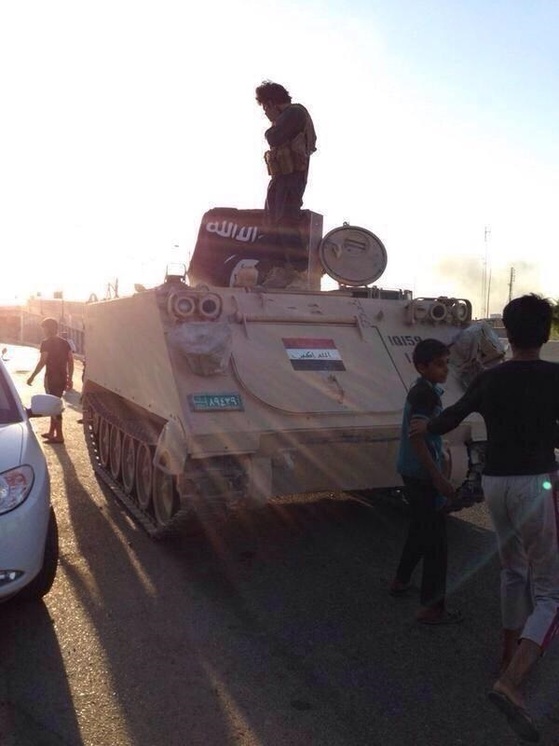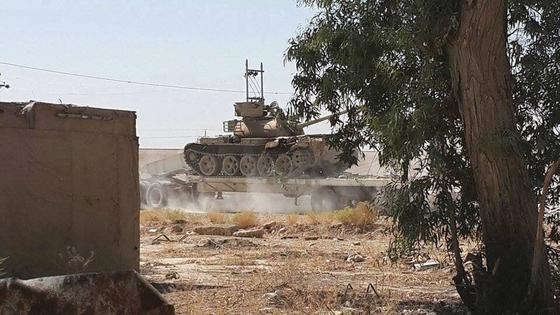The Islamic State overran an Iraqi military base in a town in Anbar province just outside of Fallujah, reportedly killing and capturing hundreds of Iraqi soldiers as well as militiamen deployed in the area during the operations.
The assault on the Iraqi military base in Saqlawiya, a town just northeast of Fallujah, was facilitated after the Islamic State took control of the nearby town of Alsigir (Al Segar or Al Sijir) one week ago. After gaining control of Alsijir, the Islamic State besieged the camp in Saqlawiya, which according to one Iraqi military officer housed more than 1,000 troops.
On Sept. 21, the Islamic State launched a suicide assault on the base. A suicide bomber driving a captured Iraqi military Humvee was able to penetrate base security and detonate his explosives, an Iraqi Army officer told Reuters. In the aftermath of the blast, an Islamic State assault team overran the base. It has been reported that those in the assault team and those involved in the initial suicide assault were dressed in Iraqi military uniforms. A small military unit is said to be holding out in Saqwaliya.
Iraqi soldiers who fled Saqlawiya were ambushed on the roads by Islamic State fighters. The roads and the area surrounding the base have been described as the “kilometer of death.”
The number of soldiers killed, captured, and missing has not been disclosed by the Iraqi Ministry of Defense. An Iraqi officer who escaped the assault told Reuters that “of an estimated 1,000 soldiers in Saqlawiya, only about 200 had managed to flee.” These numbers have been corroborated by other Iraqi soldiers who escaped the area.
An Iraqi government official told the National Iraqi News Agency that 50 Iraqi soldiers and “sons of popular mobilization,” likely members of the Awakening, were confirmed killed.
On Sept. 24, the Islamic State released a statement that purported to detail the battle. The statement was obtained and translated by SITE Intelligence Group:
“After placing trust in Allah, and taking into consideration the means and available capabilities, and by the order of the Ministry of War, al-Fallujah Province mobilized all its military detachments, air defense, support, and raiding detachments, and after making the plan and setting its goals, the detachments launched towards their desired objective, which is liberating the area of al-Sijir from the filth of the Safavids [a derogatory term for Shiites], as a first step to besiege the headquarters of Brigade 30, which is located between the area of al-Sijir and the al-Saqlawiyah sub-district.”
The Islamic State also claimed that the Iraqi military lost 300 men, 4 M1 Abrams tanks, a “Russian” tank, 3 BMP’s, 41 Humvees, and various other vehicles and weapons during the assault on the base. It is unclear if the Islamic State destroyed the armored vehicles or captured them.
Iraqi officers and soldiers blamed senior military leaders for failing to provide ammunition, food, water, and supplies to the troops trapped in Saqlawiya. Prime Minister Haider al Abadi ordered two Iraqi generals, including the deputy army chief of staff for operations, to retire.
In what appears to be part of an effort to deflect criticism of inaction, the Iraqi Ministry of Defense released a video of what it said was warplanes destroying Islamic State technicals as well as targeting homes near Saqlawiya that are said to be used by the Islamic State.
The Islamic State has demonstrated that it is capable of conducting offensive operations despite more than six weeks of US airstrikes that have targeted the group in Irbil, Ninewa, Salahaddin, Anbar, and Babil provinces. The US military has launched more than 194 airstrikes against the Islamic State inside Iraq since Aug. 7. An additional 16 airstrikes have been launched against the jihaidst group inside Syria since Sept. 22. [See LWJ report, US targets Islamic State in 3 strikes in Syria, Iraq.]
The Islamic State took control of Fallujah and other smaller cities and towns in Anbar at the beginning of this year, and remains in control of much of the province, including parts of the capital of Ramadi. The jihadist group has launched sophisticated attacks in the province, and even routed an Iraqi armored column, which included US-supplied M1 Abrams tanks and M113 armored personnel carriers, in the town of Khalidiyah, which is just west of Saqlawiya. [See LWJ report, Islamic State routs Iraqi armored column in Anbar.]
Pictures allegedly taken from Saqlawiya:
Below is the video released by the Iraqi Ministry of Defense, in which several technicals and houses are destroyed during fighting. According to the title, the video was taken near Al Sijir:










9 Comments
Why did the American military not respond to this attack? No one had advanced notice? No satellites? Can’t be! With cruise missiles, F16’s, F18’s, F15’s, F22’s, drones, yet no response? The US military seems to be only able to kill two to three guys at a time with drone attacks. These drones don’t seem able to be present at large gatherings. Considering all the technology of the American military, this lack of a response is baffling. I suspect there is a larger story here that is being missed. This whole Middle East thing is a damning, entangling fur ball!
Do you know what Iraqi aircraft were used in the strikes?
The IS must be salivating at the prospect of taking Baghdad, defended as it is by a pretend army.
Hmm. I got a left field idea. Could the Iraqi Government be deliberately “tanking” to draw the US into a ‘boots on the ground’ commitment?
adam:
Well, no. It is insanity to believe the Islamic State ever could have taken Baghdad by force. There is a large Shiite population, as well as other sects and ethnicity who would rise up in arms, literally, to defend the city; there are multiple brutal Shia militias there who have been tasked to defend the city at absolutely all costs, and they are very deadly and effective groups; the Iraqi armed forces have multiple military units deployed all over the capital and it’s belts, with heavy armor, some air support (Iraqi and U.S.); and most importantly, Baghdad tips into the southern Shiite heartlands of Iraq.
If in a parallel dimension the Islamic State did take over, the Shia from the south, probably even the entire international community would team up to immediately push the Islamic State out of the capital.
US airpower being applied is enough to provide video and for a cooperative press to hold up as evidence of the WH doing something. In fact it’s likely no much more than harrassment. The operational area is vast the forces committed limited. The rules of engagement and the requirement that targets be approved by the WH rule out any sort of effective close air support. Its mostly noise and not likely decisive against a determined enemy.
It may be worth continuing bomb especially with an aim toward destroying as much infrastructure as possible to and economic activity in the ISIS controlled area as possible.
Other than that, let ISIS expand until it bumps into populations willing to resist. Not sure where that will be. Kurds are probably worth investing in. I would do nothing for the Shites they have proven themselves to be more liability than asset.
In the mean time we are wearing out our forces and equipment faster than we can or will reconstitute it.
With the 6 million a day (that the US states IS gains from oil production) are they not looking for stinger missiles? Or some equivalent from the Lord of War (Nicholas Cage). I bet Russia would funnel some anti-air/anti-drone technology their way, through backstage brokers of course.
The only fact is that the Iraqi soldier is very good at leaving his post and running, so why should the U.S. use it’s airpower to assist them. In the end, where do they run to, the Iranian border?
Meanwhile, U.S. airpower IS NOT being used to help the Kurds in Kobane, who have kept ISIS at bay for over two weeks! What give, here?
Dave I think you are correct. The Turks are saying the US should spearhead any ground assault so yes I would believe they are tanking to draw us in. The IA has all but abandoned towns and cities won by US military, and want us to do the work of Iraqi Shia.